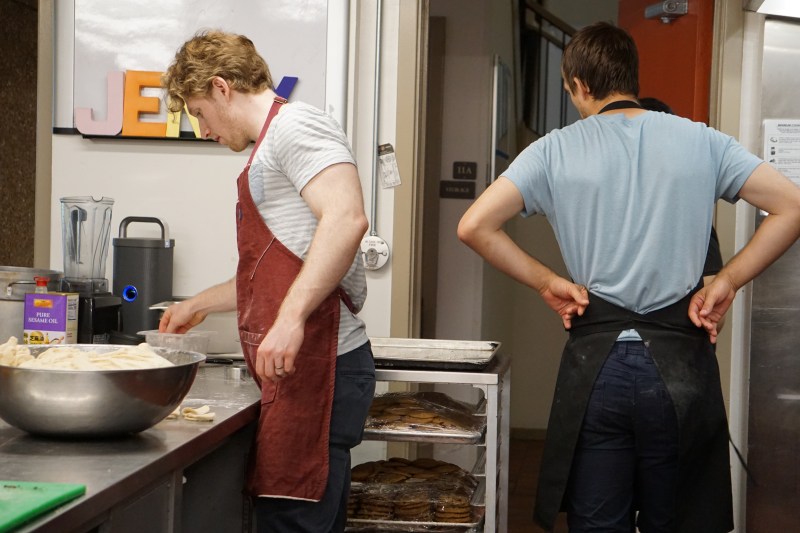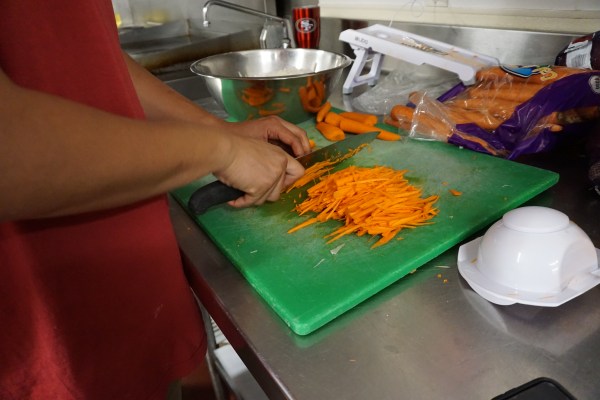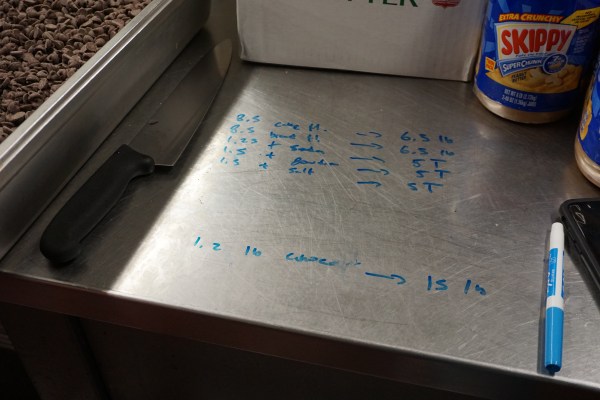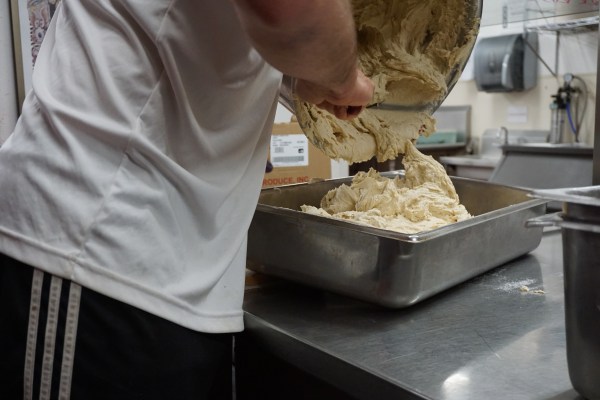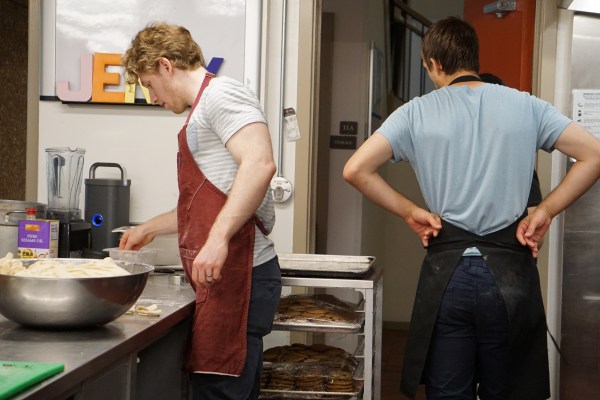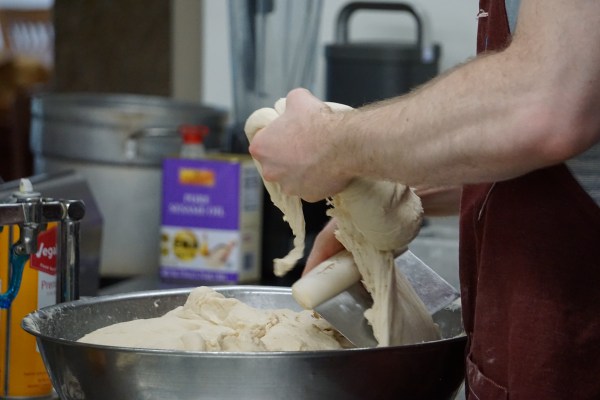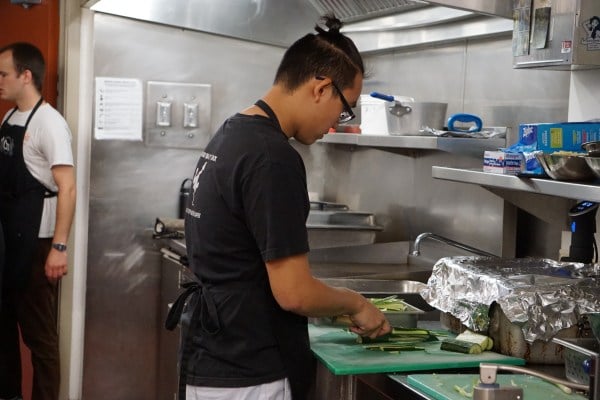Three days before Cru dinner
Nitery 206, 7:30 p.m.
Anthony Nguyen ’17 MS ’18 is marking up a whiteboard in red — there’s an ambitious list of about 7 dishes splashed up already, from banh mi to buns to spiced pork ribs, a menu heavily inspired by David Chang’s Momofuku cookbook.
Roving around the table, the team behind Cru dinner takes turns “claiming” dishes. Cedric Yue ’17 MS ‘18 is the point person for buns, Jeffrey Yu ’18 on wings.
It seems like Anthony is the leader of this group, but the question of equitable dishes for vegetarians pops up and all eyes are on Nate Gruver ’18.
His casual demeanor, accentuated by his habit of rocking onto the back legs of his chair, belies the experience Nate has in the culinary arts. Nonchalantly, he suggests a giant deep-fried or roasted cauliflower, reminiscent of the signature dish at ABCV in New York.
Cru dinner is the brainchild of Nate, whose first iteration of the exclusive, prix fixe meal was covered by the Daily back in 2016. Since then, Gruver estimates that he’s served about 15 dinners total, holding as many as four per quarter.
Not only has the frequency of the dinners increased, but the Cru team has also scaled up in other dimensions. Their first dinner only served 45 people in two seatings. Their largest dinner to date was sponsored by the Class of 2019 last spring, where Cru prepared a special dinner for 100 then-sophomores. Cru member Benedict Bolton ’19 remarks that it was one of his favorites, because the sponsorship of the Class of 2019 reduced the dinner price from $15-25 to an accessible $5, letting a more diverse crowd into the magic.
And it is magic indeed. This is not your mom’s dinner party.
I had the privilege of going to their fall 2017 dinner, which featured 7 courses including homemade Parmesan popovers, sous vide duck, Vietnamese inspired salmon tartare and a yuzu sorbet. At their most expansive, Cru served a 14 course dinner in 2016.
Of course, such an endeavor would not be possible without a dedicated team. Nate has the most experience in professional kitchens, having worked in restaurants since age 15 and more recently, a stint in Benu, a San Francisco restaurant with three Michelin stars. Benedict, a serious bespectacled junior, works the “front of the house,” handling seatings, reservations and other logistics. Andrew seems like the Cru equivalent of a chef de cuisine, creating the menu with Nate’s input and organizing a massive Costco/99Ranch grocery trip. Others, like Jeffrey Yu ‘18, Vanna Tran ‘18, Colin Clemmons ’18, Miller Perrin ‘18 and Cedric, help with cooking.
Nate himself recruited most of the team. “I taught him in French Cooking,” he says, pointing at Andrew. “I taught him (Colin) in Marcus Covert’s class on the science of cooking and I kind of taught him (Benedict) in German baking.”
However, I’m here because I’ve heard that this is the final Cru dinner and I want to know why. Clearly Stanford students love it — every Cru dinner has sold out. And juniors like Benedict seem committed to helping out.
“It’s hard to give 150 percent to something,” says Nate, “and not a lot of freshmen in college are good at cooking.” Moreover, most of the Cru team are graduating this spring.
“It’s hard,” echoes Colin. “It’s something I look forward to and dread, simultaneously.”
“You’re working 4:30 to midnight on a Saturday, where you’re on your feet doing something nonstop,” says Benedict.
“We serve the dishes and we wash them all too, because of the two seatings,” adds Andrew.
“And we’ve got to leave the kitchen cleaner than we found it,” pipes in Benedict again. (“Is that why the chef at French House hates you?” Colin asks Nate, who shrugs.)
The overlapping conversation reflects the general vibe of the team. There’s no Gordon Ramsey here. Nate is encouraging to the team members who seem daunted by the herculean task at hand and it’s clear that he takes his role very, very seriously.
Yet there’s also a sense of readiness to retire. Nate and Andrew refer several times to feeling “burnt out.” In the past, the team workshopped original dishes, some inspired by experiences at high-end restaurants in the area. Teams would be assigned to various sections of the menu, and would test recipes for Nate to taste and approve. This final dinner is more casual, and Nate admits to “pushing Andrew to take on more of a leadership position.” Nate’s even relegated himself just to desserts, “because they’re easier,” but I get the sense that he’ll have his hands full anyway.
“Maybe if Cru had a different inception, if we had more casual food like this dinner, it could work,” Nate muses, “because this is something more cooks at Stanford are capable of.”
Two days before Cru dinner
Jerry, 10 p.m.
It’s a two-man team of Andrew and Nate working in the Jerry kitchen. Andrew is meticulously slicing carrots and radishes to be pickled for the banh mi.
On the other end of the kitchen, Nate stands by the industrial mixer, which is churning so vigorously that it has to be covered with a dish towel to prevent globs of cookie dough from splashing out. (Nate’s secret to perfect cookies, soft in the middle and crisp on the outside? Creaming the butter and sugar for a long time to incorporate as much air as possible into the dough.)
There aren’t any recipes to be seen anywhere — just a few lines of proportions that Nate’s scrawled with dry-erase marker onto the counter.
He’s making three kinds of cookies — chocolate chip, peanut butter and a brownie sort inspired by Momofuku Milk Bar.
This last dinner is extra ambitious — they sold 150 tickets, 75 per seating. Nate asks me to guess how many pounds of butter they bought. I estimate 30, which is right on the nose.
At the very least, Andrew says, this dinner will be served family style, so the team doesn’t have to stress over making the hundreds of intricate platings as they have in the past.
As Nate splits the creamed mixture into separate tubs (there’s too much to fit in the mixer), I ask if he cooks often, since he lives in a co-op. “I actually don’t cook dinners that much,” he replies. “I like cooking on my own terms.”
It’s a similar reason for his career goals in tech, not cooking. “What if you disrupted the restaurant industry?” I ask, half-jokingly. For half a beat, he seems to consider it.
Contact Samantha Wong at slwong ‘at’ stanford.edu.
